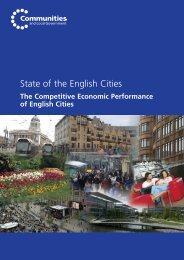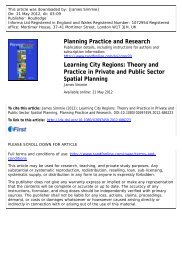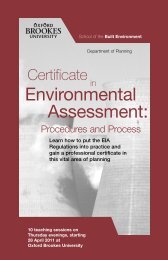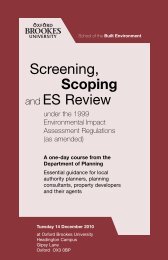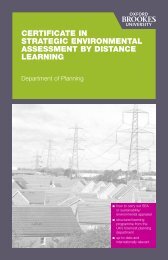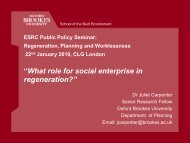History Matters: Path dependence and innovation in British city ...
History Matters: Path dependence and innovation in British city ...
History Matters: Path dependence and innovation in British city ...
Create successful ePaper yourself
Turn your PDF publications into a flip-book with our unique Google optimized e-Paper software.
Figure 11: Change <strong>in</strong> proportions of employees classified to R&D <strong>and</strong> higher education <strong>in</strong><br />
selected cities 1981-2005<br />
6<br />
5<br />
4<br />
Percentage of<br />
employees<br />
<strong>in</strong> R&D or<br />
higher<br />
education<br />
3<br />
2<br />
1<br />
0<br />
1981 1991<br />
2005<br />
Years<br />
Read<strong>in</strong>g Leeds Oxford Aldershot Cambridge<br />
Northampton Warr<strong>in</strong>gton Great Brita<strong>in</strong><br />
Newport<br />
Swansea Wakefield Norwich Middlesbrough<br />
Read<strong>in</strong>g this decl<strong>in</strong>ed dur<strong>in</strong>g the 1980s <strong>and</strong><br />
recovered dur<strong>in</strong>g the 1990s. At the same time<br />
capa<strong>city</strong> <strong>in</strong> Warr<strong>in</strong>gton decl<strong>in</strong>ed steadily over<br />
the entire period although it rema<strong>in</strong>ed just<br />
above the <strong>British</strong> average <strong>in</strong> 2005. Newport<br />
<strong>and</strong> Wakefield failed to register any research or<br />
higher education employees over the 24 years.<br />
The difference between these two <strong>city</strong>-regions<br />
at the bottom of the rank<strong>in</strong>g <strong>in</strong> 2005 with<br />
no employees <strong>in</strong> R&D, <strong>and</strong> Cambridge at the<br />
top with 4 per cent employees <strong>in</strong> R&D, was<br />
considerable. They represent a major difference<br />
between the relative capa<strong>city</strong> of these <strong>city</strong>regional<br />
economies to identify <strong>and</strong> assimilate<br />
new knowledge. It is also of some concern<br />
that only Cambridge among the top ranked<br />
economies has a higher proportion of R&D<br />
employees <strong>in</strong> 2005 than it had <strong>in</strong> 1981. This is<br />
one <strong>in</strong>dicator of the structural changes tak<strong>in</strong>g<br />
place <strong>in</strong> the local economies.<br />
One might expect R&D or other knowledge<br />
assets to affect the output of local high-tech<br />
manufactur<strong>in</strong>g. But the evidence suggests<br />
no such correlation. Where there has been a<br />
decl<strong>in</strong>e <strong>in</strong> the proportion of R&D employees<br />
this has <strong>in</strong>deed often been the case. So, cities<br />
with significant R&D employment <strong>in</strong> 1981<br />
that subsequently decl<strong>in</strong>ed – as <strong>in</strong> Read<strong>in</strong>g<br />
<strong>and</strong> Warr<strong>in</strong>gton – saw a relative decl<strong>in</strong>e <strong>in</strong><br />
employment <strong>in</strong> their high-tech manufactur<strong>in</strong>g<br />
sectors <strong>in</strong>clud<strong>in</strong>g computers, electronic<br />
components <strong>and</strong> scientific <strong>in</strong>struments.<br />
(Aldershot saw a decl<strong>in</strong>e <strong>in</strong> computers <strong>and</strong><br />
electronic components). But output also fell<br />
<strong>in</strong> Cambridge, the only <strong>city</strong> to experience<br />
an overall relative <strong>in</strong>crease <strong>in</strong> R&D <strong>and</strong> HE<br />
employees; yet <strong>in</strong> Oxford, the resurgence of<br />
R&D dur<strong>in</strong>g the 1990s was marked by similar<br />
growth or resurgence <strong>in</strong> all of its ma<strong>in</strong> hightech<br />
manufactur<strong>in</strong>g sectors. It is difficult to<br />
expla<strong>in</strong> from available secondary data these<br />
differences between the two university cities.<br />
An equally complex relationship exists between<br />
knowledge workers <strong>and</strong> output <strong>in</strong> those cities<br />
with consistently below average proportions<br />
of R&D employees. In most cases this<br />
deficit was reflected <strong>in</strong> decl<strong>in</strong>es <strong>in</strong> high-tech<br />
manufactur<strong>in</strong>g: this was generally the case <strong>in</strong><br />
27





